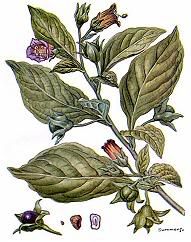DEADLY NIGHTSHADE
(also know as belladonna or
Atropa belladonna)
Description

The Belladonna has dull green leaves and bell-shaped flowers that are an unremarkable shade of purple, which yield black, shiny berries measuring approximately 1 cm in diameter. It is an herbaceous shrub, and can grow to be approximately one metre tall. The leaves have an oily feel and can cause vesicular pustular eruptions if handled carelessly.
Germination is often difficult due to the presence of germination inhibitors in the seeds. Belladonna is not common as a garden plant, and is considered a weed in some areas. It is not a very hardy perennial and is sensitive to being transplantated. Germination requires several weeks in warm, moist, absolutely sterile soil, usually far from normal garden conditions.
TOXICITY
Belladonna is one of the most toxic plants found in the Western hemisphere. Eating as few as three berries can poison a children and pose such a great danger to children because they sometimes taste sweet and look "yummy". Ingestioning just one of it's leafs can be fatal to an adult. The Belladonna is also toxic to many domestic animals and livestock though many animals, such as rabbits, birds and deer, seem to eat the plant without suffering harmful effects. It has not been verified, but many reports suggest that people have been poisoned by eating animals which have previously eaten Belladonna. The root of the plant is generally the most toxic part. All parts of the plant contain tropane alkaloids, such as atropine which is the most well known of the tropane alkaloids.

There are many symptoms on can get from being poisoned by the Belladonna. The reason for most symptoms is the atropine inhibiting the production of acetylcholine in the nerve synapse preventing the parasympathetic nervous system (PNS) from sending out electrical nerve impulses. Since the PNS regulates non-volitional/subconcious activities such as sweating, breathing, and heart rate, when it can't send out signals the heartbeat and breathing become extremely irregular.
symptoms include:
- tachycardia
- Dilated pupils and/or blurred vision
- hallucinations and/or confusion
- loss of balance and/or a feeling of flight
- staggering or a sense of suffocation
- paleness followed by a red rash
- The skin can completely dry out and slough off
- husky voice and/or extremely dry throat
- constipation and/or urinary retention
Fatal cases have a rapid pulse that turns feeble. The antidote is physostigmine or pilocarpine, the same as for atropine.
(Info summarized From Wikipedia)








 The Belladonna has dull green leaves and bell-shaped flowers that are an unremarkable shade of purple, which yield black, shiny berries measuring approximately 1 cm in diameter. It is an herbaceous shrub, and can grow to be approximately one metre tall. The leaves have an oily feel and can cause vesicular pustular eruptions if handled carelessly.
The Belladonna has dull green leaves and bell-shaped flowers that are an unremarkable shade of purple, which yield black, shiny berries measuring approximately 1 cm in diameter. It is an herbaceous shrub, and can grow to be approximately one metre tall. The leaves have an oily feel and can cause vesicular pustular eruptions if handled carelessly. There are many symptoms on can get from being poisoned by the Belladonna. The reason for most symptoms is the atropine inhibiting the production of acetylcholine in the nerve synapse preventing the parasympathetic nervous system (PNS) from sending out electrical nerve impulses. Since the PNS regulates non-volitional/subconcious activities such as sweating, breathing, and heart rate, when it can't send out signals the heartbeat and breathing become extremely irregular.
There are many symptoms on can get from being poisoned by the Belladonna. The reason for most symptoms is the atropine inhibiting the production of acetylcholine in the nerve synapse preventing the parasympathetic nervous system (PNS) from sending out electrical nerve impulses. Since the PNS regulates non-volitional/subconcious activities such as sweating, breathing, and heart rate, when it can't send out signals the heartbeat and breathing become extremely irregular.








